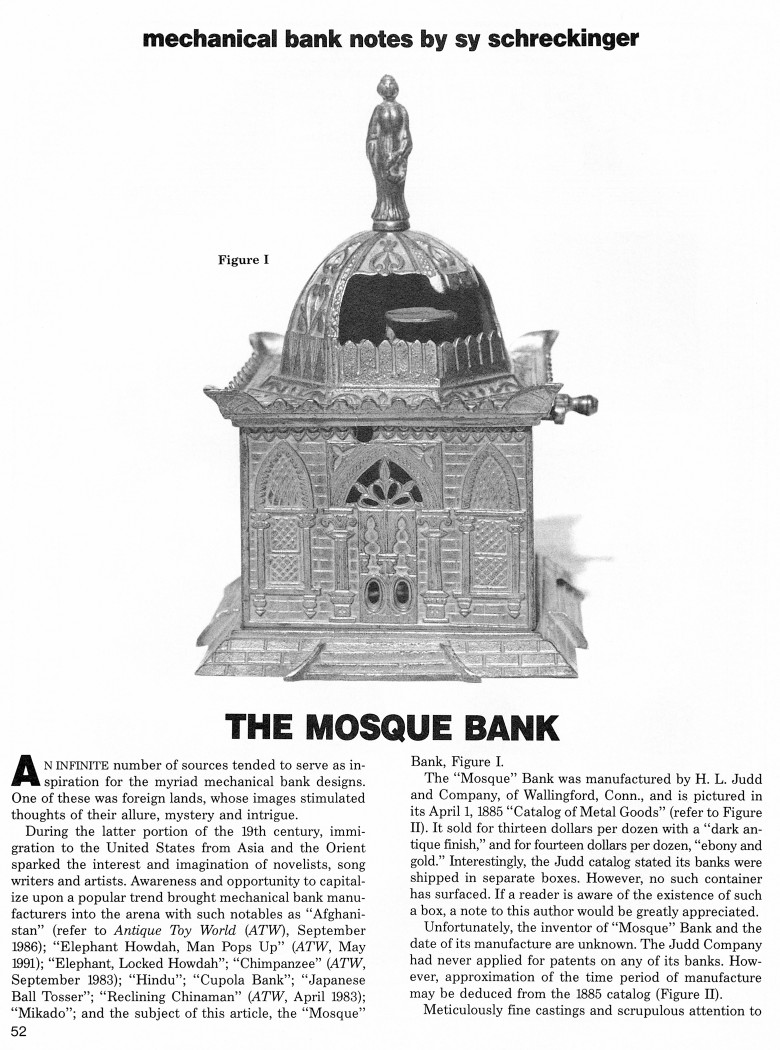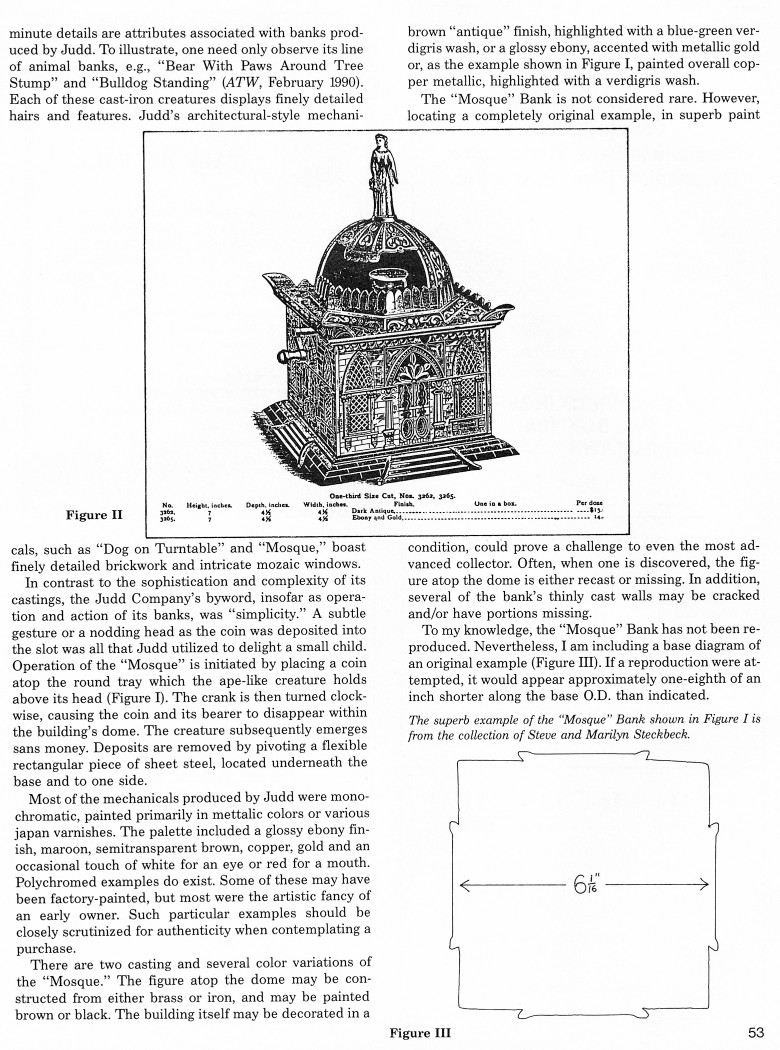|
The Mosque Bank
by Sy Schreckinger – ANTIQUE TOY WORLD Magazine – September,
1995
An infinite number of sources tended to serve
as inspiration for the myriad mechanical bank designs. One of these was
foreign lands, whose images stimulated thoughts of their allure, mystery
and intrigue.
During the latter portion of the 19th century, immigration to the
United States from Asia and the Orient sparked the interest and
imagination of novelists, song writers and artists. Awareness and
opportunity to capitalize upon a popular trend brought mechanical bank
manufacturers into the arena with such notables as "Afghanistan" (refer to
Antique Toy World (ATW),
September 1986); "Elephant Howdah, Man Pops Up" (ATW,
May 1991); "Elephant, Locked Howdah"; "Chimpanzee" (ATW,
September 1983);
"Hindu"; "Cupola Bank"; "Japanese Ball Tosser"; "Reclining Chinaman" (ATW,
April 1983); "Mikado"; and the subject of this article, the "Mosque" Bank,
Figure I.
The "Mosque" Bank was manufactured by H. L. Judd and Company, of
Wallingford, Conn., and is pictured in its April 1, 1885 "Catalog of Metal
Goods" (refer to Figure II). It sold for thirteen dollars per dozen with a
"dark antique finish," and for fourteen dollars per dozen, "ebony and
gold." Interestingly, the Judd catalog stated its banks were shipped in
separate boxes. However, no such container has surfaced. If a reader is
aware of the existence of such a box, a note to this author would be
greatly appreciated.
Unfortunately, the inventor of "Mosque" Bank and the date of its
manufacture are unknown. The Judd Company had never applied for patents on
any of its banks. However, approximation of the time period of manufacture
may be deduced from the 1885 catalog (Figure II).
Meticulously fine castings and scrupulous attention to minute details
are attributes associated with banks produced by Judd. To illustrate, one
need only observe its line of animal banks, e.g., "Bear With Paws Around
Tree Stump" and "Bulldog Standing" (ATW,
February 1990). Each of these
cast-iron creatures displays finely detailed hairs and features. Judd's
architectural-style mechanicals, such as "Dog on Turntable" and "Mosque,"
boast finely detailed brickwork and intricate mosaic windows.
In contrast to the sophistication and complexity of its castings, the
Judd Company's byword, insofar as operation and action of its banks, was
"simplicity." A subtle gesture or a nodding head as the coin was deposited
into the slot was all that Judd utilized to delight a small child.
Operation of the "Mosque" is initiated by placing a coin atop the round
tray which the ape-like creature holds above its head (Figure I). The
crank is then turned clockwise, causing the coin and its bearer to
disappear within the building's dome. The creature subsequently emerges
sans money. Deposits are removed by pivoting a flexible rectangular piece
of sheet steel, located underneath the base and to one side.
Most of the mechanicals produced by Judd were monochromatic, painted
primarily in metallic colors or various japan varnishes. The palette
included a glossy ebony finish, maroon, semitransparent brown, copper,
gold and an occasional touch of white for an eye or red for a mouth.
Polychromed examples do exist. Some of these may have been
factory-painted, but most were the artistic fancy of an early owner. Such
particular examples should be closely scrutinized for authenticity when
contemplating a purchase.
There are two casting and several color variations of the "Mosque."
The figure atop the dome may be constructed from either brass or iron, and
may be painted brown or black. The building itself may be decorated in a
brown "antique" finish, highlighted with a blue-green verdigris wash, or a
glossy ebony, accented with metallic gold or, as the example shown in
Figure I, painted overall copper metallic, highlighted with a verdigris
wash.
The "Mosque" Bank is not considered rare. However, locating a
completely original example, in superb paint condition, could prove a
challenge to even the most advanced collector. Often, when one is
discovered, the figure atop the dome is either recast or missing. In
addition, several of the bank's thinly cast walls may be cracked and/or
have portions missing.
To my knowledge, the "Mosque" Bank has not been reproduced.
Nevertheless, I am including a base diagram of an original example (Figure
III). If a reproduction were attempted, it would appear approximately
one-eighth of an inch shorter along the base O.D. than indicated.
The superb example of the "Mosque" Bank shown in Figure I is from the
collection of Steve and Marilyn Steckbeck.
|

